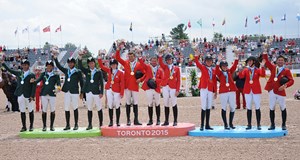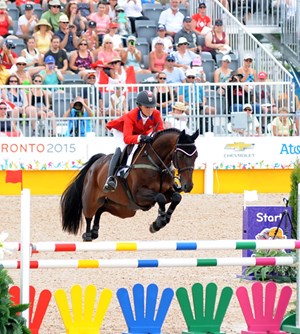 The U.S. Pan American Games gold medal eventing team is in the center of the podium flanked by the silver medal squad from Brazil (left) and bronze medal Canada in ceremonies today. | Photo copyright 2015 by Lawrence J. Nagy
The U.S. Pan American Games gold medal eventing team is in the center of the podium flanked by the silver medal squad from Brazil (left) and bronze medal Canada in ceremonies today. | Photo copyright 2015 by Lawrence J. NagyJuly 19, 2019 — Mission accomplished.
The U.S. eventing team qualified today for the 2016 Olympics with impressive performances at the Pan American Games, leading wire-to-wire while earning the gold medal (133 penalties) over rising star Brazil (140.70) and Canada (163).
Wait. I should say “missions accomplished,” because the eventers’ achievement came on the heels of the dressage squad earning its way into the Rio Games next year with team gold. I know you read that here last weekend, but I just thought I’d remind you that this has been a great Pan Ams for the U.S. equestrians.
Just as Steffen Peters earned individual gold for the U.S. in dressage, Marilyn Little did the same for eventing. Her expert fault-free trip on RF Scandalous added nothing to her dressage score of 40.3 penalties.
 U.S. Pan Am individual eventing gold medalist Marilyn Little has a joyful victory gallop on RF Scandalous. | Photo copyright 2015 by Lawrence J. Nagy
U.S. Pan Am individual eventing gold medalist Marilyn Little has a joyful victory gallop on RF Scandalous. | Photo copyright 2015 by Lawrence J. NagyShe was understandably emotional, wiping tears away as she talked about her experience on her first senior international championships team.
“Nothing really compares to this,” she said.
“It’s indescribable. It’s a very exciting day for all of us, and for all the people who made it possible for it to happen.”
Of her mare, known as Kitty, Marilyn said simply, “She was everything I hoped she’d be.”
Canada’s Jessica Phoenix, the defending gold medalist, also finished on her dressage mark (42.1) aboard a wonderfully willing Pavarotti to take silver. Ruy Fonseca of Brazil led individually through dressage and cross-country. But into each life some rain must fall, and as he was finishing his round–the last one of the day–the showers began. It was, I guess, just a coincidence that he had a knockdown at the final fence with Tom Bombadill Too, dropping him to third on 42.9 penalties.
 Defending Pan Am eventing individual gold medalist Jessica Phoenix of Canada rose to the occasion this time with an individual silver and team bronze on Pavarotti. | Photo copyright 2015 by Nancy Jaffer
Defending Pan Am eventing individual gold medalist Jessica Phoenix of Canada rose to the occasion this time with an individual silver and team bronze on Pavarotti. | Photo copyright 2015 by Nancy JafferOf course it was disappointing, but proudly wearing his pair of medals, team silver and individual bronze, (they are enormous, seemingly almost the size of saucers) he was gracious about his reversal of fortune. I was impressed by Ruy’s demeanor. Listen to what he had to say by clicking on this soundbyte.
 He lost the individual gold but won individual bronze and team silver, so Brazilian eventer Ruy Fonseca was happy enough as his discipline wrapped up at the Pan Am Games. | Photo copyright 2015 by Lawrence J. Nagy
He lost the individual gold but won individual bronze and team silver, so Brazilian eventer Ruy Fonseca was happy enough as his discipline wrapped up at the Pan Am Games. | Photo copyright 2015 by Lawrence J. NagyAsked what he would do with his medals, he said he would give them to Tom Bombadill, whom he characterized as “a very sensitive horse…who needs to enjoy what he does.”
Interestingly, the Brazilian team is composed of men who rode together in Pony Club north of Sao Paulo 30 years ago. They are changing the face of their country’s eventing program as they continue training with two-time Olympic gold medalist Mark Todd. They will be trying very hard to be on the podium in their homeland next year, you can be sure of that.
Boyd Martin was fourth on Pancho Villa with 44.3 penalties, followed by Carlos Lobos of Chile on the very interesting Ranco, a horse who looks as if he definitely understands the game. I don’t automatically think of Chile when I think of eventing, but he did his country proud.
Carlos wore his military uniform, as did a number of riders from Latin America. Don’t forget, eventing used to be called “the military,” because its origins were with the army. Dressage demonstrated how well a horse could perform on the parade grounds; cross-country simulated being able to get a message to the front during wartime, whatever the obstacles, and stadium jumping demonstrated that after the demands of the first two stages, the horses were fit to continue.
A third U.S. rider, Lauren Kieffer, also finished on her dressage score of 48.4 with Meadowbrook’s Scarlett to wind up seventh.
Like Scandalous, Scarlett is a mare (I’ll bet you figured that out) and Lauren had something interesting to say about pairing with an equine female athlete.
“A good mare is really, really good and a bad one’s really, really bad,” Lauren observed.
“They’ve got a whole lot of fight in them when it comes down to it. They very much think for themselves. That can come to your advantage when you’re in trouble. They’ll find a way out and can kind of stay ahead of the game for you, and they play the game.”
Phillip Dutton, the team’s senior rider and pathfinder on cross-country, had a knockdown at the second fence that put him 10th (52.4) with Fernhill Fugitive.
I talked with Boyd and Phillip about the day and the U.S. achievement. Hear their thoughts by clicking below.
U.S. eventing hasn’t had a great time of it recently, as Phillip indicated. At the 2012 Olympics, the squad finished seventh, and at last year’s World Equestrian Games, the team didn’t finish. The leadership changed after the 2012 Olympics, with David O’Connor–2000 Olympic individual gold medalist and former USEF President (he’s multi-dimensional)–becoming the coach.
 U.S. eventing coach David O’Connor and Marilyn Little | Photo copyright 20156 by Lawrence J. Nagy
U.S. eventing coach David O’Connor and Marilyn Little | Photo copyright 20156 by Lawrence J. NagyThis certainly is a step in the right direction. Remember, though, it takes time to build a team, and after two years, David’s efforts are working. True, the Pan Ams are a 2-star, not a 4-star like the WEG and the Olympics, but it shows his team is going in the right direction. And under the pressure of qualifying for the Olympics too.
David and I talked about it after the competition. His comments were interesting, so listen in.
There were 32 starters on Michel Vaillancourt’s show jumping course today, back at the OLG Caledon Equestrian Center, where the stands were just about filled. (Sadly, as soon as it began to rain, many people fled and only a few stayed around for the medal ceremonies.)
Eighteen competitors, more than half the field, were double-clear, including the lowest-placed finisher, Sarka Kolackova of Guatamala on Sir Royal. Good for her. That smile she flashed after the finish was heart-warming.
The original field of 42 was cut by 10 after yesterday’s cross-country phase in Mono, north of here. There were six falls, but no serious injuries.
Cross-country course designer Wayne Copping of Australia called it a dream result.
“I’d been warned about all these wild South American countries’ (riders) that just gallop and pick the fences off. But I was surprised, I was very pleased to see the way they ride,” he commented.
Of the smaller countries not known for eventing, he said, “I don’t see a lot of them, but absolutely, they have to be improving because (of) their coaching and training standards; they’re competing more world-wide and the standard of the horses is improving. So they have to have taken a step from the last Pan Ams to this one. Otherwise, there’s something seriously wrong.”
Be sure to go to www.facebook.com/practicalhorseman for more photos from eventing.
Visit these links for the individual results and team results.
I’ve been bemused by the Pan Am organization’s tendency to play, “Born in the USA” for the American equestrian team victory laps. Half of the dressage team, Steffen and Sabine Schut-Kery, were born in Germany. Half of the eventing team, Boyd and Phillip, were born in Australia. I think they needed another song, but now they might as well continue for grand prix show jumping, since I believe everyone on that U.S. squad was indeed born in the USA.
I won’t be around to hear that tune again, as I have other commitments and am heading out now after 11 days up here. The show jumping team qualified for the Olympics at the World Equestrian Games last year, so although the gold definitely is part of its agenda, the pressure of making a cut for Rio is off. They face several competitive squads; I wish the best of luck to them.
The Pan Ams have been very interesting and at times, frustrating. I call it “Olympics lite,” since it only covers one hemisphere instead of the globe. Happily, that means the problems tend to be smaller and easier to solve, to some extent, and I didn’t feel the pressure that often is overwhelming at the Olympics.
Athletes don’t run into the same roadblocks that media must handle. As Boyd noted, all the riders have to do is ride; everything else is taken care of for them by the U.S. Olympic Committee, the U.S. Equestrian Federation and the funding prowess of the U.S. Equestrian Team Foundation.
USEF Director of Sport Will Connell once pointed out to me, the athletes are “on the other side of the wire.”
On this side of the wire, we make do for ourselves and things don’t necessarily go smoothly. But at these Games, what helped a great deal were the terrific volunteers. I didn’t meet one person here who wasn’t friendly, helpful and polite.
I’ll look back fondly on these Pan Ams, even though I had to become adept at smuggling food (mostly rolls) into the venue (it wasn’t allowed, and we never found out why not.) Water was easier only after I found out you could bring in a sealed (unopened bottle). That’s just one of those Games things, I guess.
My next postcard is coming from the Hampton Classic at the end of August, so be sure to look for it.
Until then,











